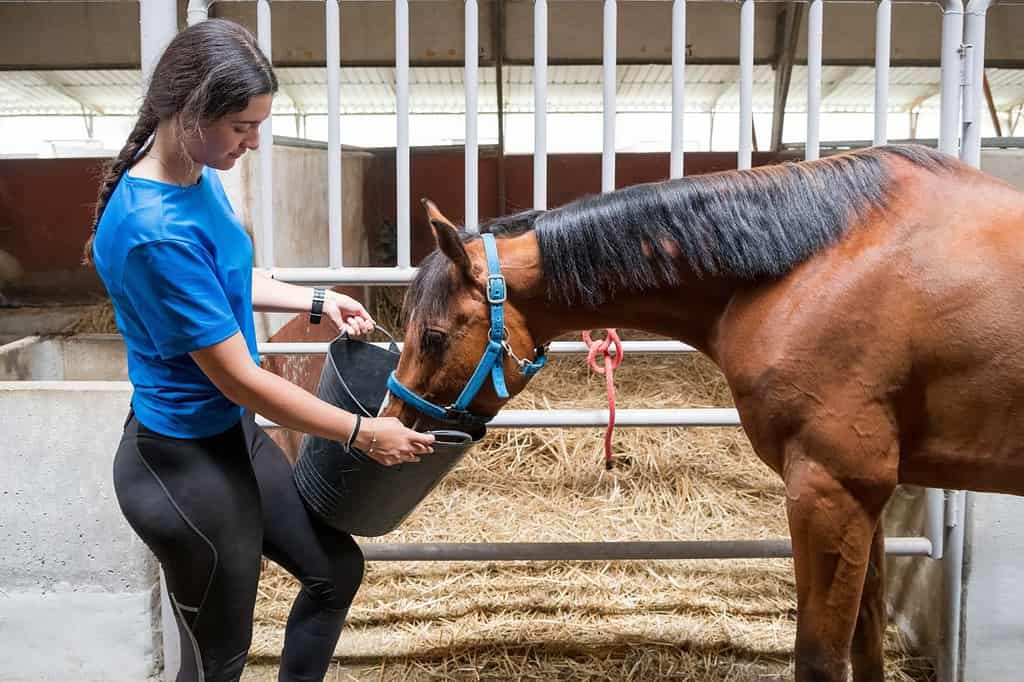The connection between horses and humans is ancient, going back at least 6,000 years. Initially, it was a practical relationship: horses provided transportation, assisted with heavy loads, and offered an advantage in battle. Over many centuries, the relationship between humans and horses deepened, and the two species developed a profound connection. Today, horses offer companionship, inspiration, and even healing through equine therapy.
A History of Humans, Horses, and Healing

After World War One, Oxford Hospital in England used calvary horses to help rehabilitate soldiers.
©Bobby Ware/iStock via Getty Images
Historians debate over the exact time and place of the domestication of horses, but we know that they were likely used by humans at least 6,000 years ago. In 600 BCE, Orbasis believed that riding horses was valuable to human health. The ancient Greek physician Hippocrates, often considered the “Father of Medicine”, suggested that natural exercise — including horseback riding — provided physical benefits.
Fast forward to the 1952 Olympics, Lis Hartel of Denmark won the silver medal in the equestrian sport of dressage. This was a phenomenal feat, as Hartel had contracted polio eight years before! She was paralyzed below the knees and could neither mount nor dismount a horse on her own. However, once she began to ride, Hartels’ disability disappeared, revealing the potential benefits of equine-assisted activities. Then during the 1960s, the Community Association for Riders with Disabilities (CARD) and the Professional Association of Therapeutic Horsemanship were formed.
What Is Equine Therapy?

Working with horses can help build trust and confidence.
©Photology1971/Shutterstock.com
Equine therapy is a therapeutic practice that includes interacting with a horse. Horses are prime candidates for healing due to their steady nature, mindfulness, emotional intelligence, and even their physiology.
Horses are superb masters of body language, picking up on subtle shifts in our posture, feelings, and emotional state. Trauma and pain can disconnect us from our bodies, projecting an outward calm while emotional chaos reigns just below the surface. While not all humans may notice this discrepancy, horses quickly pick up on how your inside and outside worlds are not in sync.
A horse will respond to such incongruences in many different ways. They may step back or refuse to engage until you can bring your external and internal states into balance. This is extremely useful in therapy as it helps the guest to check in, recognize hidden emotions, and practice authentic communication.
Horses read and process multiple cues to understand what a human is feeling, including our emotional expressions and tone of voice — and they notice when the two don’t quite match. For example, you might put on a happy face, but if your voice sounds angry or sad, a horse will pick up on the incongruence. In addition, horses can observe and interpret interactions as a third party, and then apply what they learned later on. Horses also reflect our emotions and feelings back to us instantly and with uncanny accuracy. Serving as a type of emotional mirror, they can help therapists pinpoint areas that need attention and help people process their feelings.
What Is Equine Therapy Used For?

Research shows that spending time with horses helps to calm our nervous systems.
©Alexia_Khrushcheva/iStock via Getty Images
Equine-Assisted Psychotherapy
Many types of therapeutic practices involve horses. In equine-assisted psychotherapy, for example, clients interact with horses but do not do any riding. Instead, they provide husbandry and care. Clients feed, bathe, groom, and pet horses, or lead them to certain areas. The horses, in turn, can choose whether or not to participate, either moving closer or further away from the client. This is a very important aspect of equine-assisted psychotherapy, as it models healthy boundaries and self-awareness.
In addition, there is usually an equine specialist and a mental health professional who develop a plan for interacting with the horse. The horse helps to provide a safe environment for healing, wherein clients can learn and practice social skills, problem-solving skills, empathy, emotional regulation, and healthy boundaries. The horse helps to create comfort, consistency, and safety, providing non-judgmental support to the client.
Hippotherapy
Hippotherapy is another type of horse therapy. The name may sound funny, but it is not at all connected to hippopotamuses. Instead, “hippo” is an ancient Greek that means “horse”.
According to the American Hippotherapy Association, hippotherapy is used in occupational and physical therapy and speech-language pathology. It serves as a tool to help engage neuromotor, cognitive, and sensory systems.
During hippotherapy, a therapist helps to guide clients through different exercises on horseback. The horse’s steady movements help to improve coordination, balance, neural function, and sensory processing. Research also suggests that it may help as a complementary treatment for people with arthritis, head injuries, cerebral palsy, spinal cord injury, stroke, multiple sclerosis, and behavioral and psychiatric disorders.
How and Why Does Equine Therapy Help?

People of all ages can participate in equine therapy.
©Borislava Tsiporkova/iStock via Getty Images
More research is needed, and equine therapy is not a substitute for traditional medical practices. However, so far scientists have found that working with horses can be an excellent complementary treatment for improving mental, emotional, and physical health. For example, when we feel anxious, our heart rate can speed up to 100 beats per minute. A horse’s resting heart rate, on the other hand, is a nice 44 beats per minute. Horses live in the present moment and are masters of mindfulness. How can this help us? Well, research demonstrates that horses emit an electromagnetic field around their hearts that can extend 6 feet or more. This “field” helps pull down the heart rate of anxious humans near the horse through synchronous co-regulation.
Equine therapy with a certified professional can be used for people of all ages and may help with a wide variety of health concerns, including (but not limited to):
- Depression
- Anxiety
- Eating disorders
- Generalized anxiety disorder (GAD)
- Social anxiety disorder
- PTSD
- Veterans
- Substance misuse
- ADHD
- Autism
- Addiction
- Grief
- At-risk youths
- Neglect and abuse
- Chronic illness
- Dementia
- Building trust
- Older adults with cognitive or functional impairments
- Rebuilding self-awareness, self-acceptance, self-compassion, and self-worth
- Cerebral palsy
- Strokes
- Arthritis
- Head injuries
- Spinal cord injuries
- Multiple sclerosis
- Behavioral and psychiatric disorders.
The photo featured at the top of this post is © Magnifical Productions/iStock via Getty Images
Thank you for reading! Have some feedback for us? Contact the AZ Animals editorial team.







